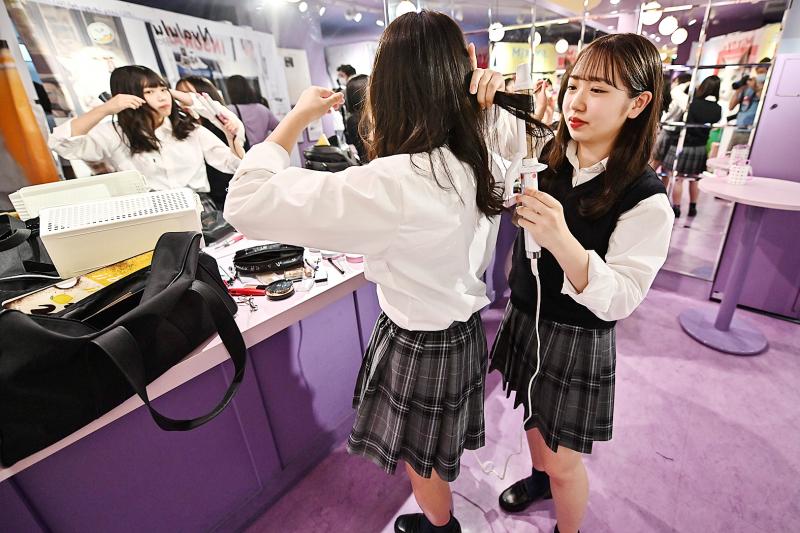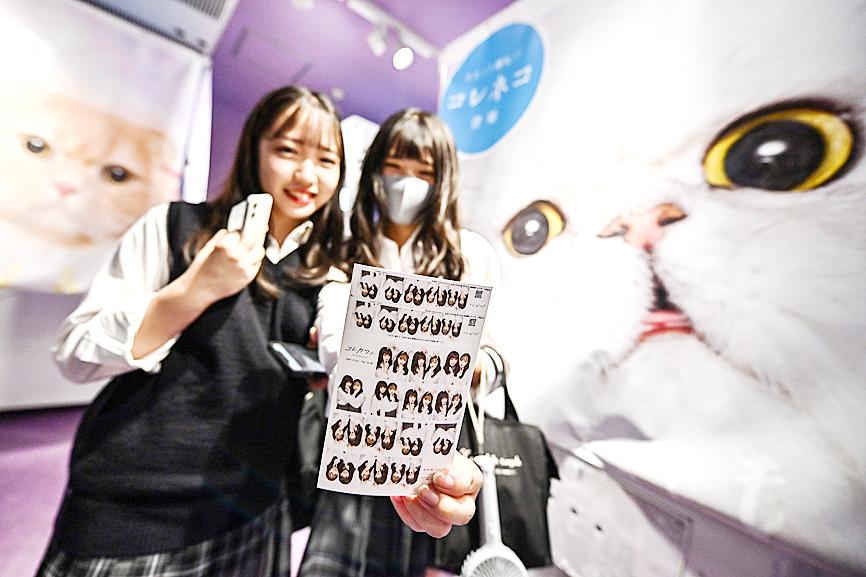A pair of Japanese schoolgirls primp their hair before a long mirror, preparing for the perfect picture, but they are not taking a smartphone selfie, they are using a purikura photo booth.
Old-style photo booths have staged something of a comeback in parts of the world in the past few years, for their nostalgic value in the smartphone era, but the purikura — an abbreviation of the Japanese pronunciation of “print club” — offers much more than a simple strip of passport photographs.
Featuring a dizzying array of retouches, enhancements and adornments, they remain hugely popular 25 years after they debuted in Japan, particularly with teenage girls and young women enamored with their kawaii, or cute, output.

Photo: AFP
Despite competition from smartphones and increasingly sophisticated retouching apps, at least one Japanese firm is banking on the purikura’s enduring appeal and rolling out a new model this year.
Nonoka Yamada, 17, has been a purikura fan for almost a decade, and said that she and friends use them several times a week.
“All the girls in my class take purikura,” she said as she prepped for her picture at a department store in Tokyo’s Shibuya district.

Photo: AFP
“The first time I used one I was eight, and the camera lens was too high so I had to stand on my tiptoes,” she said, adding that purikura offer more than a simple smartphone selfie.
“It lets you make yourself look cute, you can change your face,” she said. “I want to put the pictures on Instagram ... the images are good quality with good lighting.”
The first purikura was the brainchild of Japanese firm Atlus Co Ltd, which launched the product in partnership with Sega Corp in July 1995.
The booths quickly became a popular feature at Japanese gaming arcades, where long lines of schoolgirls waiting to have their photos taken transformed the previously male-dominated arcade customer base.
Other companies quickly jumped into the market, which by 1997 was worth more than US$950 million a year, but the selfie era took a toll, with users increasingly able to take and retouch photos free with their phones, rather than paying about ¥400 (US$3.78) for a sheet of about 16 photos.
Some manufacturers went under, while others abandoned the purikura business for more profitable ventures.
Today, just one manufacturer remains: FuRyu Corp, a former affiliate of the Japanese electronics firm Omron Corp.
“In 1997, we launched our first machine using Omron technology, which offered caricature faces. It was a total flop,” FuRyu spokeswoman Yuki Hikita said. “It had nothing to do with what young girls wanted, probably because it was developed by middle-aged men.”
The company began consulting customers directly and credits focus-grouping with its longevity.
In the past few years, the market has stabilized, with about 10,000 purikura dotted around the country — down from the 1997 peak of 50,000.
While the booths are less pervasive these days, they remain popular — a FuRyu phone app for receiving purikura photos had 19 million registered users in March.
Yuka Kubo, an independent researcher who studies the purikura phenomenon, has traced how the booths evolved over time.
Early models featured little more than cutesy borders around photos, with the first limited retouching tools debuting around 1998.
Facial recognition technology incorporated in 2003 allowed specific features to be altered, particularly the eyes.
“That was the start of the fashion for enormous eyes,” said Kubo, referring to a popular feature giving customers the doe-eyed gaze of anime characters.
“It started a competition between manufacturers, driven by demand from girls, over who could offer the biggest eyes,” she said.
In the past few years, retouching options have become more sophisticated, offering tints and shades to give the appearance of perfect skin or a slimmer face, and while smartphones and apps offer retouching features, Hikita said that there is still room for purikura.
“To take a good selfie with a phone, you need a bit of skill,” she said.
With purikura, “everything is automatic, with professional equipment and lighting, like a studio photo.”
The COVID-19 pandemic has meant new measures to keep customers safe, including disinfectant at every booth, but it has not kept fans away.
“Customers are already coming back, much faster than we had expected,” Hikita said.
In a sign of the sector’s enduring appeal, Sega announced this month that — more than two decades since it launched the first model — it would introduce a new version later this year, with the goal of “spreading purikura culture.”

TAKING STOCK: A Taiwanese cookware firm in Vietnam urged customers to assess inventory or place orders early so shipments can reach the US while tariffs are paused Taiwanese businesses in Vietnam are exploring alternatives after the White House imposed a 46 percent import duty on Vietnamese goods, following US President Donald Trump’s announcement of “reciprocal” tariffs on the US’ trading partners. Lo Shih-liang (羅世良), chairman of Brico Industry Co (裕茂工業), a Taiwanese company that manufactures cast iron cookware and stove components in Vietnam, said that more than 40 percent of his business was tied to the US market, describing the constant US policy shifts as an emotional roller coaster. “I work during the day and stay up all night watching the news. I’ve been following US news until 3am

UNCERTAINTY: Innolux activated a stringent supply chain management mechanism, as it did during the COVID-19 pandemic, to ensure optimal inventory levels for customers Flat-panel display makers AUO Corp (友達) and Innolux Corp (群創) yesterday said that about 12 to 20 percent of their display business is at risk of potential US tariffs and that they would relocate production or shipment destinations to mitigate the levies’ effects. US tariffs would have a direct impact of US$200 million on AUO’s revenue, company chairman Paul Peng (彭雙浪) told reporters on the sidelines of the Touch Taiwan trade show in Taipei yesterday. That would make up about 12 percent of the company’s overall revenue. To cope with the tariff uncertainty, AUO plans to allocate its production to manufacturing facilities in

Six years ago, LVMH’s billionaire CEO Bernard Arnault and US President Donald Trump cut the blue ribbon on a factory in rural Texas that would make designer handbags for Louis Vuitton, one of the world’s best-known luxury brands. However, since the high-profile opening, the factory has faced a host of problems limiting production, 11 former Louis Vuitton employees said. The site has consistently ranked among the worst-performing for Louis Vuitton globally, “significantly” underperforming other facilities, said three former Louis Vuitton workers and a senior industry source, who cited internal rankings shared with staff. The plant’s problems — which have not

TARIFF CONCERNS: The chipmaker cited global uncertainty from US tariffs and a weakening economic outlook, but said its Singapore expansion remains on track Vanguard International Semiconductor Corp (世界先進), a foundry service provider specializing in producing power management and display driver chips, yesterday withdrew its full-year revenue projection of moderate growth for this year, as escalating US tariff tensions raised uncertainty and concern about a potential economic recession. The Hsinchu-based chipmaker in February said revenues this year would grow mildly from last year based on improving supply chain inventory levels and market demand. At the time, it also anticipated gradual quarter revenue growth. However, the US’ sweeping tariff policy has upended the industry’s supply chains and weakened economic prospects for the world economy, it said. “Now